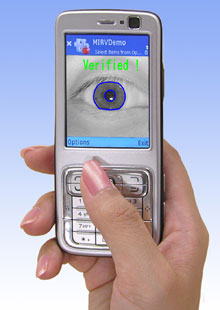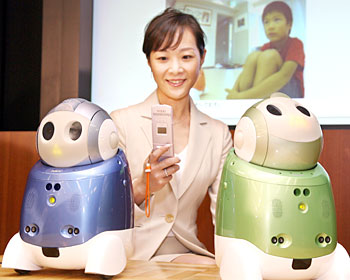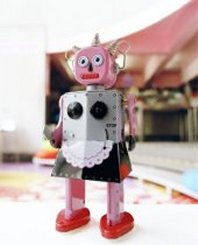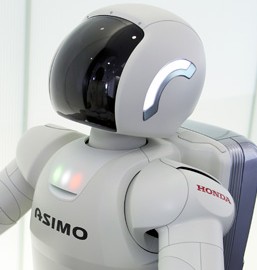Feb 25, 2007
Grand challenges proposed by the U.K. Computing Research Committee
Re-blogged from KurzweilAI.net
Grand challenges proposed by the U.K. Computing Research Committee include a project to unify cognitive science, artificial intelligence, and robotics.
One sign of success would be a robot capable of functioning at the level of a 2- to 5-year-old child. Another milestone could be a robot capable of autonomously helping a disabled person around a house without explicit preprogramming about its environment.
Other challenge is intended to create more dependable computers and associated software systems, which oversee the bulk of the world's financial transactions, regulate life-saving instruments, and manage the delivery of products.
Read Original Article>>
12:18 Posted in AI & robotics, Research institutions & funding opportunities | Permalink | Comments (0) | Tags: artificial intelligence, robotics
Jan 21, 2007
Cognitive robotics
Via Mind Hacks
Memoirs of a Postgrad has an interesting analysis of cognitive robotics - the science of developing 'cognitive agents'
23:47 Posted in AI & robotics | Permalink | Comments (0) | Tags: artificial intelligence
Jan 15, 2007
Research Positions in the Devlopment of Artificial Companions - Edinburgh
Via Usability News
Deadine: 20 January 2007
Centre for interaction Design, Napier University, Edinburgh
Salary Level Research Associate (Grade IA)
£20,645 - £30,902 p.a. (dependent on experience)
Opportunities exist for talented individuals to join Napier University’s team, led by Professor David Benyon, to work on a €12 million EU funded project, COMPANIONS. This project concerns the development of persistent, intelligent agents that work with people to help carry out activities within digital space. Napier’s work focus is the interaction design of these companions.
An Interaction Designer is required to undertake field work, analysis, prototyping and evaluation of systems using a variety of media such as video and Flash animation. The Interaction Designer will be a creative individual who can contribute to the interface, functionality, affective characteristics and embodiment of the companions.
A Conceptual Modeller or software engineer is needed for the development of a meta-data schemata for the mark-up of behaviours, language processing and modality selection. This will result in a COMPANIONS mark-up language.
For either position, the successful applicant will require a higher degree (or significant industry experience) in human-centred computing or interaction design. She or he should have good writing, team working, creative and communication skills, and have experience with techniques appropriate to the position.
Part time or short term contract positions may also be available. In addition, two fully funded PhD studentships (worth approx. £12000 p.a.) may be associated with the project.
Informal inquiries should be directed to the COMPANIONS research fellow Dr Oli Mival, o.mival@napier.ac.uk. Full applications in the form of a CV and covering letter should be received by 20th January 2007, electronically to c.thomson@napier.ac.uk or by post to Cheryl Thomson, Faculty of Engineering, Computing and Creative Industries, Napier University, 10, Colinton road, Edinburgh EH14 1DJ.
23:25 Posted in Research institutions & funding opportunities | Permalink | Comments (0) | Tags: artificial intelligence
Call for Articles for: Encyclopedia of Artificial Intelligence
Via Neurodudes
From the call for articles
Editors: Juan R. Rabuñal, Julián Dorado & Alejandro Pazos
Nature has always been a source of inspiration for science problem solving. Areas such as Pharmacy, Physics or Aeronautics use biological concepts to reach beyond their current limits.
As far as Computing Science and - more specifically, Artificial Intelligence (AI) - is concerned, the use of biological concepts is highly reliable for achieving good results. At the early stages of AI (1950s), Artificial Neural Networks (ANN) - quite successful as classification and pattern recognition systems - were developed by using the structure of the nervous system as a basis. After these systems, biology has inspired the development of other techniques - among which the evolutionary systems are the most promising ones when dealing with new problems that use a vast amount of data - such as Biomedical Computing or weather forecasting.
Both the techniques based in cell or natural organisms performance, as well as those based on evolutionary theories, have a wide success record when applied to real problems. These types of techniques currently represent a very active area of research, as not only a high number of companies use them, but also many related high level scientific congresses are being held annually on these techniques.
Coverage
To meet this need, currently we are in the process of editing the "Encyclopedia of Artificial Intelligence " that will provide comprehensive coverage and definitions of the most important issues, concepts, trends and technologies in Artificial Intelligence. This important new publication will be distributed worldwide among academic and professional institutions and will be instrumental in providing researchers, scholars, students and professionals with access to the latest knowledge related to Artificial Intelligence techniques.
To ensure that this publication has the most current and relevant coverage of all topics related to Artificial Intelligence, we are asking sholars well-known for their particular area of research, to contribute short articles of 1,500-3,500 words on any of the following topics.
22:45 Posted in AI & robotics | Permalink | Comments (0) | Tags: artificial intelligence
The University of Washington Neural Systems Lab have created a humanoid robot you can control with your thoughts.
![]() Via Mind Hacks
Via Mind Hacks





 Researchers at the University of Washington Neural Systems Lab have created a humanoid robot you can control with your thoughts via a EEG-based non-invasive brain-computer interface.
Researchers at the University of Washington Neural Systems Lab have created a humanoid robot you can control with your thoughts via a EEG-based non-invasive brain-computer interface.
Link to Neural Systems Lab robot info page



20:52 Posted in Brain-computer interface | Permalink | Comments (0) | Tags: brain-computer interface, artificial intelligence, robotics
Jan 11, 2007
The euCognition network
thx to Giuseppe Riva
The principal goal of the euCognition network is to leverage added-value from existing work through interaction and to use this to encourage further contributions from new participants. A key objective of the network is to foster interaction between all the many different scientific sectors involved in this multi-disciplinary area and to help create truly inter-disciplinary perspectives. The network activities will cover the four key issues of:
-
Outreach
-
Scientific Outlook
-
Education
-
On-line Resources for the Community
You can get a good idea of the goals of the network and the way it works from the euCognition website
19:55 Posted in Research tools | Permalink | Comments (0) | Tags: artificial intelligence, research tools
Jan 10, 2007
Researchers Use Wikipedia To Make Computers Smarter
Via KurzweilAI.net
Using Wikipedia, Technion researchers have developed a way to give computers knowledge of the world to help them "think smarter," making common sense and broad-based connections between topics just as the human mind does.
21:55 Posted in AI & robotics | Permalink | Comments (0) | Tags: artificial intelligence
Jan 07, 2007
Scientists have designed and built an immersive table tennis simulation that allows a human to compete against a computer
Via KurzweilAI.net
Scientists have designed and built an immersive table tennis simulation that allows a human to compete against a computer..
23:19 Posted in AI & robotics | Permalink | Comments (0) | Tags: artificial intelligence, robotics
Dec 30, 2006
Evolved Virtual Creatures
Via Suicide Bots
From the Evolved Virtual Creatures website
This video shows results from a research project involving simulated Darwinian evolutions of virtual block creatures. A population of several hundred creatures is created within a supercomputer, and each creature is tested for their ability to perform a given task, such the ability to swim in a simulated water environment. Those that are most successful survive, and their virtual genes containing coded instructions for their growth, are copied, combined, and mutated to make offspring for a new population. The new creatures are again tested, and some may be improvements on their parents. As this cycle of variation and selection continues, creatures with more and more successful behaviors can emerge.
The creatures shown are results from many independent simulations in which they were selected for swimming, walking, jumping, following, and competing for control of a green cube.
Download movie from the Internet Archive
swimming
13:35 Posted in AI & robotics | Permalink | Comments (0) | Tags: artificial intelligence, robotics
Dec 22, 2006
Recent trends in robot-assisted therapy environments
Recent trends in robot-assisted therapy environments to improve real-life functional performance of affected limbs.
J Neuroengineering Rehabil. 2006 Dec 18;3(1):29
Authors: Johnson MJ
ABSTRACT: Upper and lower limb robotic tools for neuro-rehabilitation are effective in reducing motor impairment but they are limited in their ability to improve real world function. There is a need to improve functional outcomes after robot-assisted therapy. Improvements in the effectiveness of these environments may be achieved by incorporating into their design and control strategies important elements key to inducing motor learning and cerebral plasticity such as mass-practice, feedback, task-engagement, and complex problem solving. This special issue presents nine articles. The novel strategies covered in this issue encourage more natural movements through the use of virtual reality and real objects and faster motor learning through the use of error feedback to guide acquisition of natural movements that are salient to real activities. In addition, several articles describe novel systems and techniques that use of custom and commercial games combined with new low-cost robot systems and a humanoid robot to embody the supervisory presence of the therapy as possible solutions to exercise compliance in under-supervised environments such as the home.
00:13 Posted in AI & robotics, Cybertherapy | Permalink | Comments (0) | Tags: artificial intelligence, robotics, cybertherapy
Nov 28, 2006
A Smarter Computer to Pick Stocks
| Via KurzweilAI.net Wall Street is adopting nonlinear decision making processes akin to how a brain operates, including neural networks, and genetic algorithms, and other advanced computer-science techniques. |
23:41 Posted in AI & robotics | Permalink | Comments (0) | Tags: artificial intelligence
Nov 22, 2006
Black Starfish
Via the Neurophilosopher
Josh Bongard, Victor Zykov and Hod Limpton of Cornell University’s Computational Synthesis Laboratory have designed and built the Black Starfish, a four-legged robot which “automatically synthesizes a predictive model of its own topology (where and how its body parts are connected) through limited yet self-directed interaction with its environment, and then uses this model to synthesize successful new locomotive behavior before and after damage.”
08:50 Posted in AI & robotics | Permalink | Comments (0) | Tags: artificial intelligence
Nov 06, 2006
Iris recognition technology for mobile phones
Re-blogged from Pink Tentacle

Oki Electric announced the development of iris recognition technology for camera-equipped mobile phones. Unlike Oki’s previous iris recognition technology that relies on infrared cameras for the iris scan, the new technology uses ordinary cellphone cameras. With plans to make the technology commercially available in March 2007, Oki hopes to boost the security of cellphone payment systems. According to Oki, any camera-equipped cellphone or PDA can perform iris recognition once the special software is installed. Identification accuracy is said to be high, with only 1 in 100,000 scans resulting in error, and the system can tell the difference between flesh-and-blood eyes and photographs.
23:23 Posted in AI & robotics, Wearable & mobile | Permalink | Comments (0) | Tags: artificial intelligence, mobile phones
Nov 01, 2006
HAL
Via Engadget

HAL (short for Hybrid Assistive Limb) is a robotic suite designed "to expand and improve physical capabilities of human being".
The system, a brainchild of Yoshiyuki Sankai, engineering professor at Tsukuba University, is getting ready for mass production, Engadget reports. The robotic suite could be used in applications such as "walking assistance and rehabilitation, nursing, factory work and disaster relief."
HAL is originally developed to help elderly or disabled people walk around with their own legs and HAL-3 achieved the primary goal in 2000.In 2005, the latest model HAL-5 was given upper body limbs as well as weight saving and more compact POWER units, longer life battery and much smaller control unit and spectacularly designed outer shells.
HAL is a robot suit which can expand and improve physical capabilities of human being. By wearing HAL-5 and you can hold up to 40 kg load by arms and can increase the maximum weight of leg press from 100 kg to 180 kg.
Read more at Engadget
22:20 Posted in AI & robotics, Cybertherapy | Permalink | Comments (0) | Tags: artificial intelligence, robotics, cybertherapy
Oct 30, 2006
Vision-body link tested in robot experiments
Re-blogged from KurzweilAI.net
"Embodied cognition" experiments involving real and simulated robots suggest that the relationship between physical movement and sensory input could be crucial to developing more intelligent machines...
Read the full article
14:46 Posted in AI & robotics | Permalink | Comments (0) | Tags: artificial intelligence, robotics
Oct 27, 2006
PaPeRo Robot Childcare In Japan
Via Technovelgy
NEC and NTT have jointly produced PaPeRo (short for Partner-type Personal Robot), the latest of a series of domestic robots. PaPeRo uses a camera in each eye to navigate and has image recognition capabilities to track and identify individual children. Further, it is equipped with a mobile phone that allows parents to control him at distance, as well as to talk to children directly or with text messages

22:02 Posted in AI & robotics | Permalink | Comments (0) | Tags: artificial intelligence, robotics
Vision-body link tested in robot experiments
Tests involving real and simulated robots suggest the relationship between physical movement and sensory input could be crucial to create smarter machines...
Read the full story
22:01 Posted in AI & robotics | Permalink | Comments (0) | Tags: artificial intelligence, robotics
Oct 02, 2006
Japan to invest US$17.4 million in robotics research
|
Japan’s Ministry of Economy, Trade and Industry (METI) will invest over 2 billion yen (US$17.4 million) to support the development of intelligent robots that rely on their own decision-making skills in the workplace. The objective of METI’s robot budget is to support the development of key artificial intelligence technology for robots over the next 5 years, with the goal of introducing intelligent robots to the market by 2015. |
11:00 Posted in AI & robotics, Research institutions & funding opportunities | Permalink | Comments (0) | Tags: artificial intelligence, robotics
Sep 18, 2006
Robots for ageing society

The CIRT consortium, composed by Tokyo University and a group of 7 companies (Toyota, Olympus, Sega, Toppan Printing, Fujitsu, Matsushita, and Mitsubishi), has started a project to develop robotic assistants for Japan’s aging population.
The robots envisioned by the project should support the elderly with housework and serve as personal transportation capable of replacing the automobile.
The Ministry of Education, Culture, Sports, Science and Technology (MEXT) will be the major sponsor of the research, whose total cost is expected to be about 1 billion yen (US$9 million) per year.
14:20 Posted in AI & robotics, Emotional computing | Permalink | Comments (0) | Tags: robotics, artificial intelligence
Aug 21, 2006
Post-doc position in Neural Information Processing available at Ulm University (Germany)
From the Neuro-IT mailing list
The Department of Neural Information Processing at the University of Ulm invites applications for a post-doc (or PhD student) position to begin November 1 2006, or later.
The Institute for Neural Information Processing at the University of Ulm (Germany) has two full professors, 4 postdocs and about 12 students and researchers in different areas of neural network research. Ongoing work includes mobile autonomous robots, computer vision, neural modelling, and pattern recognition.
Successful applicants will be expected to conduct research involving:- pattern recognition or sensor fusion with artificial neural networks, or
- information processing in networks of spiking neurons, or
-large associative memory systems with possible applications in autonomous vehicles, bioinformatics, medicine, speech or vision, or modelling and recognition of emotions.
Post-doc candidates should have a recent PhD-degree for example in computer science, physics, mathematics or electrical engineering.They will have some small teaching obligations, so some knowledge of German would be useful.
Applications for PhD-work are also possible. In this case the applicants should already have some experience in one of the fields mentioned above.
The appointment will be for at least 2 years. Salary will be BAT IIa (details depend on age and family status).
See for application details http://www.informatik.uni-ulm.de/neuro/
13:05 Posted in Research institutions & funding opportunities | Permalink | Comments (0) | Tags: neuroinformatics, artificial intelligence








